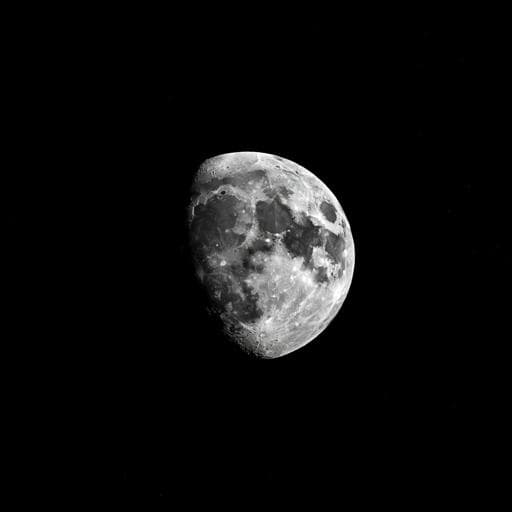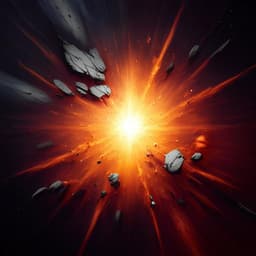
Space Sciences
Geological evidence for extensive basin ejecta as plains terrains in the Moon's South Polar Region
L. Qiao, L. Xu, et al.
Explore the intriguing findings revealing the unique origins of plains terrains in the Moon's south polar region, identified by Le Qiao, Luyuan Xu, James W. Head, Jian Chen, Yuzheng Zhang, Bo Li, and Zongcheng Ling. Their research suggests a significant impact origin, offering valuable insights for future lunar explorations focused on polar volatiles and the Moon's early bombardment history.
~3 min • Beginner • English
Introduction
The study addresses how plains terrains in the lunar south polar region relate to polar volatiles and landing site safety, provenance of materials, and early bombardment history. Polar regions likely harbor water ice and other volatiles in permanently shadowed regions, important for understanding volatile sources and planetary evolution and for in-situ resource utilization. Numerous missions (e.g., Artemis III, proposed International Lunar Research Station) target the south pole, which lies near the ancient South Pole–Aitken basin. Unlike mare-dominated prior landing sites, the south polar region is rugged, feldspathic highlands densely cratered and mantled by ejecta, complicating safe landings. Preliminary mapping suggested small plains on many crater floors resembling plains-filled equatorial craters. Key questions posed: distribution of these plains; their topography, morphology, composition, chronology compared to mare plains; their origin (volcanic vs impact-related); and their suitability for volatile exploration and implications for volatile stratigraphy and ages. The work focuses on latitudes south of 80°S to map and characterize these plains and infer their origins and exploration value.
Literature Review
Prior work established polar volatile presence and cold traps (e.g., LCROSS, Diviner), emphasized scientific priority of polar exploration, and outlined the geologic context of the south circumpolar region and South Pole–Aitken basin. Earlier geological mapping noted a lack of extensive mare and identified rugged, feldspathic terrains. Meyer et al. (2020) mapped global light plains using LROC WAC, identifying far fewer plains near the south pole due to lower resolution and shadows. Studies of Orientale light plains linked distal basin ejecta to smooth plains and described fine debris flows. Research on floor-fractured craters and polar volcanic deposits indicates volcanic materials are scarce in polar regions. Ejecta stratigraphy and megaregolith development have been studied to understand basin-wide effects. Crater chronology methods and ejecta thickness models (e.g., Pike) provide tools for age and provenance assessments relevant to this work.
Methodology
Study area: within 10° latitude of the lunar south pole (southward of ~80°S). Data: High-resolution (20 m/pixel) LOLA gridded topography; derived shaded relief (simulated illumination 315° azimuth, 10° altitude), slope (3×3 window; 60 m baseline), and roughness (RMS height) at multiple baselines (660 m, 1020 m, 1820 m). Roughness composites (RGB of the three baselines) highlight plains as dark, smooth areas across scales. LRO WAC mosaics (100 m/pixel summer mosaic) assisted geomorphology where shadows are minimal.
- Mapping: Manual delineation of plains boundaries at 1:200,000–1:400,000 scales using slope and multi-baseline roughness maps to identify flat and smooth units. Cataloged plains ≥1 km^2 (limited by 20–1000 m pixel sizes across datasets); smaller occurrences noted but not cataloged.
- Geological characterization: Compared plains topography (elevation, slope, roughness) to the entire south polar region using LOLA. Assessed albedo using LOLA 1064 nm active laser reflectance (1 km/pixel at poles; ~3 km/pixel globally). Evaluated composition using FeO abundance maps from Kaguya Spectral Profiler + LOLA (1 km/pixel; calibrated to Lunar Prospector GRS) and global Lunar Prospector GRS (0.5°). Searched for dark-halo craters and mafic-rich regolith signatures to test for cryptomaria using WAC, LOLA albedo, and mineral abundance maps.
- Morphological classification: Identified two types based on textures and features: Amundsen-type (smooth, flat, crater/inter-crater) and Schrödinger-type (flat but with small mounds/hummocky features; fractures/grabens unique to Schrödinger basin but not diagnostic of plains emplacement).
- Analog and provenance analyses: Compared with plains on floors of similarly sized craters (e.g., Parenago, Kibal’chich) and with Orientale light plains to infer ejecta flow origins versus impact melt. Used empirical ejecta thickness model (Pike 1974) with distance and deposition corrections to compute ejecta thickness at Amundsen from global craters/basins ≥10 km (Robbins database), focusing on sources with ages comparable to or younger than Amundsen. Estimated excavation/mixing depths and compared with maximum excavation depths of superposed craters to constrain deposit thickness. Calculated areal abundance of plains versus radial distance from Schrödinger and compared with patterns observed for Orientale light plains. Performed crater size-frequency distribution analyses (using kilometer-scale crater catalog) for Amundsen floor plains and Schrödinger melt to derive model ages, excluding secondaries via spatial/morphologic criteria.
Key Findings
- Inventory and distribution: Identified 873 plains sites ≥1 km^2 in the south polar region, totaling ~46,700 km^2 (~12.8% of the study area). Areas span nearly four orders of magnitude (median 9.3 km^2; some >8000 km^2). Larger examples include Schrödinger (8138 km^2), Drygalski (2584 km^2), and Amundsen (2322 km^2). About 57% lie within crater floors; 43% occur on inter-crater terrains.
- Topography and texture: Plains are significantly flatter and smoother than surrounding terrain (plains median slope ~3° at 60 m baseline; roughness ~7 m at 660 m baseline vs regional ~8° and ~25 m). Elevations range from ~−7 to +6.7 km (most −5 to −2 km; peak ~−4.7 km), generally lower than the regional peak (~−2.3 km), consistent with emplacement over older terrains.
- Albedo and composition: Plains exhibit median LOLA 1064 nm albedo ~0.32 and FeO ~7.2 wt%, similar to highland terranes and unlike mare (mare median albedo ~0.18; FeO ~16 wt%). No dark-halo craters or mafic-rich regolith detected; cryptomaria unlikely.
- Morphological types: Two classes identified: (1) Amundsen-type (dominant): very smooth, flat plains both within craters and inter-crater settings; (2) Schrödinger-type (n=9 occurrences): flat with abundant small mounds/hummocks, confined to crater interiors (including Shackleton), morphologically analogous to clast-rich impact melt units (e.g., Orientale Maunder/Montes Rook formations) and young crater floors (e.g., Copernicus).
- Provenance and source: Amundsen-type plains are best explained as ejecta-induced debris flows from distant basins/craters, especially Schrödinger. At Amundsen, modeled ejecta thickness from Schrödinger is ~61 m (second largest source Orientale ~13 m); mixing depth estimated up to ~183 m. Lack of superposed craters excavating primitive floor implies plains thickness ≥~250 m (based on maximum excavation depth 0.084×diameter of largest superposed ~2.9 km crater). Areal abundance of plains is ~5% within 1 Schrödinger radius (continuous hummocky ejecta), rising to ~15% between 1–4 radii, paralleling Orientale light plains trends. Crater CSFD model ages for Amundsen plains and Schrödinger melt are similar (~3.8–3.9 Ga), supporting a common epoch. Maximum plains areal abundance near Schrödinger (~15%) is slightly below Orientale’s (~20%), indicating multiple sources (including Orientale) contributed.
- Mapping advancement: Compared to prior mapping (Meyer et al. identified 95 plains ≥1 km^2 totaling ~29,700 km^2), this study finds many more plains due to higher-resolution, better-coverage LOLA data and mapping of regions south of 85°S.
Discussion
Findings indicate that much of the lunar south polar surface has been resurfaced by distal basin ejecta, with plains providing expansive flat terrains favorable for landings and traverses. Unlike high-standing massifs (steep slopes >20°, small flat summits, warmer and less favorable for long-term ice stability), crater-floor plains such as in Amundsen (∼70×60 km; mean slope ~5°) host numerous PSRs, some with maximum temperatures <112 K conducive to surface ice stability, and show evidence for elevated hydrogen/ice. At least 8 of 13 Artemis III candidate regions include mapped plains (often small and marginal), highlighting operational relevance. While illumination is generally less favorable than on massifs, some plains sectors achieve ~30% time-weighted illumination; nuclear power sources could mitigate energy constraints. Scientifically, plains materials, being mixtures of local substrate and distal ejecta (notably from Schrödinger), offer opportunities to sample basin ejecta and constrain basin-forming events and lunar chronology. However, provenance mixing implies crater counts and sample ages from plains likely record source-basin ages rather than host-crater formation, requiring care in interpretation.
Conclusion
The study maps 873 plains terrains totaling ~46,700 km^2 (~12.8% of the south polar study area), establishes that most are smooth, flat, high-albedo, low-FeO units distinct from mare, and demonstrates that the dominant Amundsen-type plains are ejecta-induced debris flows from distant sources, chiefly the Imbrian-aged Schrödinger basin, whereas rarer Schrödinger-type plains are local impact melt-related deposits. Ejecta thickness modeling, plains areal abundance versus distance, and CSFD ages collectively support Schrödinger as a primary source. These plains provide compelling, safer landing and exploration targets with adjacent PSRs for volatile prospecting and enable investigation of basin-forming events and lunar chronology. Future work should refine source attributions (including contributions from other basins like Orientale), improve mapping of smaller or steeper ejecta-smoothed terrains, conduct in-situ compositional and isotopic dating to constrain basin ages, and assess volatile stratigraphy within plains-associated PSRs.
Limitations
- Detection/mapping limits: Plains catalog limited to areas ≥1 km^2 and constrained by data resolutions (LOLA 20 m/pixel; albedo 1 km/pixel; FeO maps up to ~15 km at equator). Smaller or steeper ejecta-smoothed areas likely underrepresented.
- Polar imaging/albedo challenges: Low Sun angles and shadows hinder optical detection of albedo variations; reliance on active laser albedo mitigates but does not fully resolve ambiguities.
- Provenance ambiguity: While Schrödinger is supported as a major source, other basins (e.g., Orientale) also contributed; precise source fractions are uncertain.
- Chronology uncertainties: CSFD-derived ages carry inherent statistical and systematic uncertainties; plains ages may reflect source-basin resurfacing rather than host-crater formation times.
- Model dependencies: Ejecta thickness and excavation depth estimates depend on empirical models and assumptions about deposition and mixing.
- Fracture/tectonic features: Floor fractures unique to Schrödinger complicate local interpretations though not diagnostic for plains emplacement.
Related Publications
Explore these studies to deepen your understanding of the subject.







